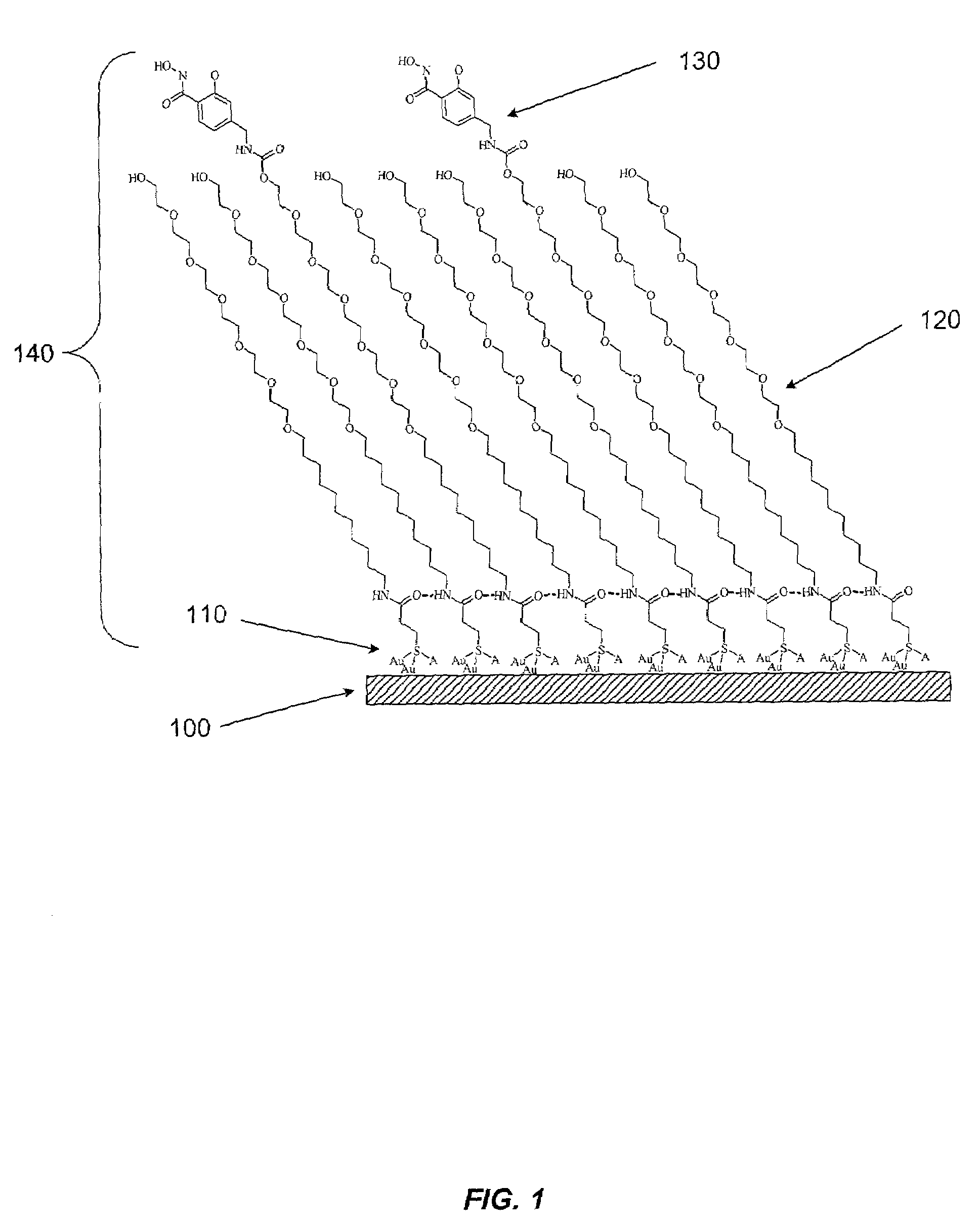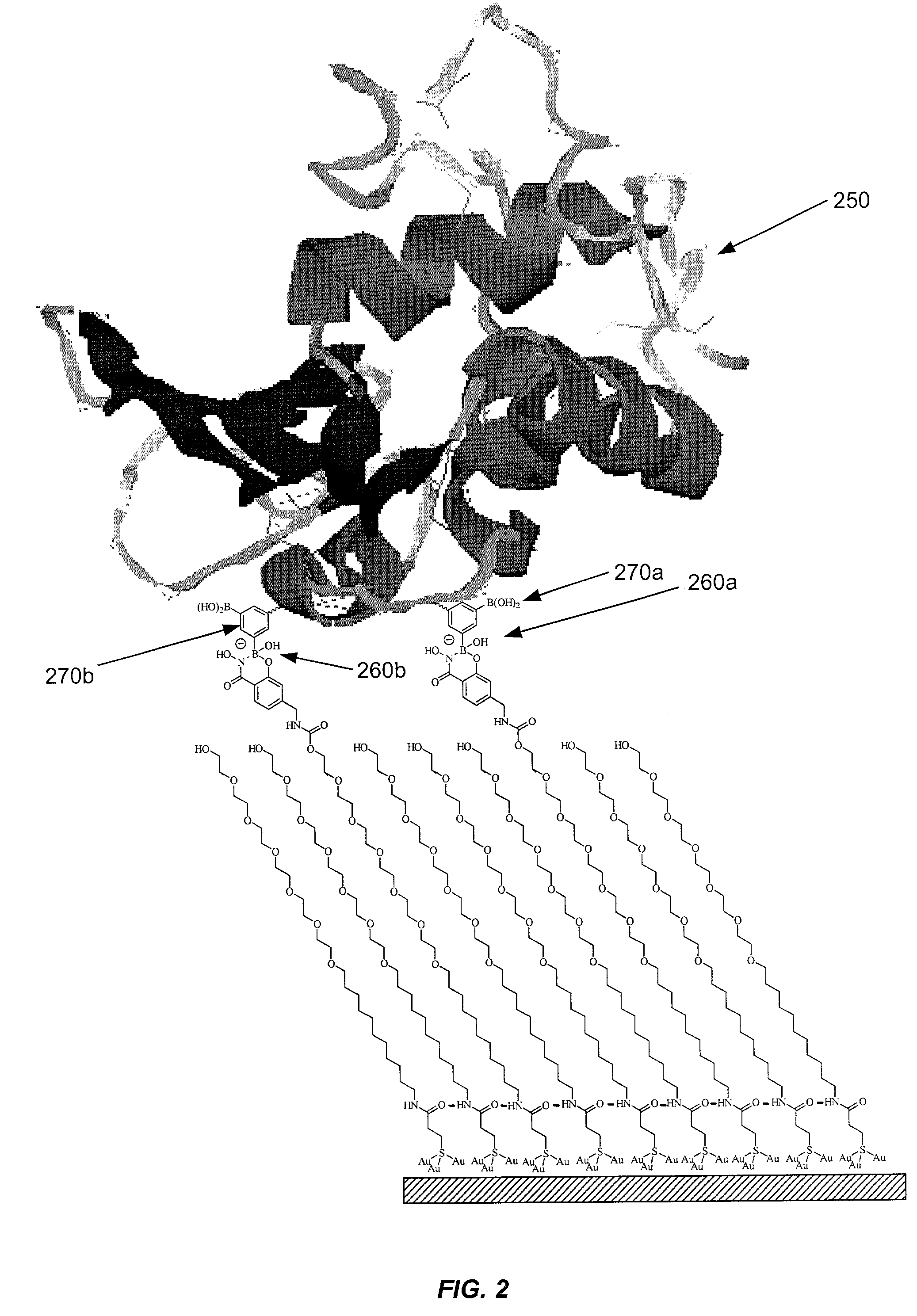Sensor surfaces for detecting analytes and methods of use
- Summary
- Abstract
- Description
- Claims
- Application Information
AI Technical Summary
Benefits of technology
Problems solved by technology
Method used
Image
Examples
example 1
Synthesis of N-(11-{2-[2-(2-Hydroxy-ethoxy)-ethoxy]-ethoxy}-undecyl)-3-mercaptopropionamide (6)
[0118]A) Synthesis of 11-tert-Butoxycarbonylamino-undecanoic acid (1)
[0119]
[0120]11-Aminoundecanoic acid (20.4 g, 101.3 mmol) and di-tert-butyldicarbonate (24.3 g, 111.0 mmol) are suspended in water (300 mL) and methanol (150 mL). Aqueous sodium hydroxide (3.13 M, 65 mL) is added, and the mixture is stirred at room temperature. After 30 minutes, the mixture became homogenous. After stirring for a total of 6 hours, the methanol was removed in vacuo. Ethyl acetate (500 mL) was added to the aqueous solution. Aqueous hydrochloric acid (1 N, 300 mL) was added slowly to the stirred mixture until the evolution of gas ceased. The pH was tested with pH paper and determined to be 4 to 5 at this point. The layers were separated, and the ethyl acetate solution was extracted sequentially with aqueous hydrochloric acid (1 N, 250 mL, water (250 mL) and brine (150 mL). The organic phase was then dried ove...
example 2
Synthesis of (3-Hydroxy-4-hydroxycarbamoyl-benzyl)-carbamic acid 2-(2-{2-[2-(2-{2-[11-(3-mercapto-propionylamino)-undecyloxy]-ethoxy}-ethoxy)-ethoxy]-ethoxy}-ethoxy)-ethyl ester (14)
[0139]A) Synthesis of (11-{2-[2-(2-t2-[2-{2-hydroxy-ethoxy)-ethoxy]-ethoxy}-ethoxy)-ethoxy]-ethoxy}-undecyl)-carbamic acid tert-butyl ester (11)
[0140]
[0141]Hexa(ethylene glycol) (75.0 g, 267 mmol was added to a round bottom flask (100 mL) and heated to 110° C. Aqueous sodium hydroxide solution (50% [w / v], 1.80 mL, 22.5 mmol) was added, and the solution was stirred for 45 minutes at 110° C. Compound 3 (12.8 g, 35.0 mmol) was added to the hot solution, and stirring was continued for 8 hours at 110° C. The reaction mixture was then cooled to room temperature, and diluted with water (300 mL). The aqueous solution was extracted three times with ethyl acetate (150 mL portions). The combined ethyl acetate extracts were dried over anhydrous magnesium sulfate, filtered and evaporated in vacuo. The crude product ...
example 3
Synthesis of N-(11-{2-[2-(2-{2-[2-{2-Hydroxy-ethoxy)-ethoxy]-ethoxy}-ethoxy)-ethoxy]-ethoxy}-undecyl)-3-mercaptopropionamide (15)
[0153]
[0154]Compound 15 was prepared from compound 11 using methods analogous to the preparation of compound 6 (Example 1, steps E and F). 1H NMR (DMSO-d6) δ 7.83 (t, 1H, J=5.5 Hz), 4.58 (t, 1H, J=5.7 Hz), 3.53–3.25 (m, 26H), 3.02 (q, 2H, J=6.3 Hz), 2.63 (m, 2H), 2.35 (t, 2H, J=6.9 Hz), 2.23 (t, 1H, J=7.8 Hz), 1.50–1.20 (m, 18H). 13C NMR (DMSO-d6) δ 169.90, 72.34, 70.30, 69.78, 69.47, 60.20, 38.43, 29.21, 29.10, 29.02, 28.98, 28.95, 28.88, 28.73, 26.36, 25.65, 20.01. HRMS (ESI-pos) calcd for C26H53NO8S 539.3492, obsd 539.3486.
PUM
| Property | Measurement | Unit |
|---|---|---|
| Fraction | aaaaa | aaaaa |
| Fraction | aaaaa | aaaaa |
| Length | aaaaa | aaaaa |
Abstract
Description
Claims
Application Information
 Login to View More
Login to View More - R&D
- Intellectual Property
- Life Sciences
- Materials
- Tech Scout
- Unparalleled Data Quality
- Higher Quality Content
- 60% Fewer Hallucinations
Browse by: Latest US Patents, China's latest patents, Technical Efficacy Thesaurus, Application Domain, Technology Topic, Popular Technical Reports.
© 2025 PatSnap. All rights reserved.Legal|Privacy policy|Modern Slavery Act Transparency Statement|Sitemap|About US| Contact US: help@patsnap.com



